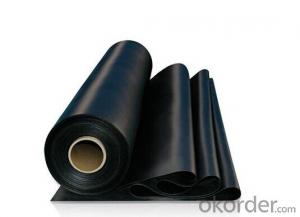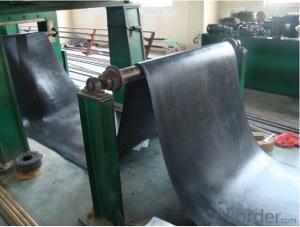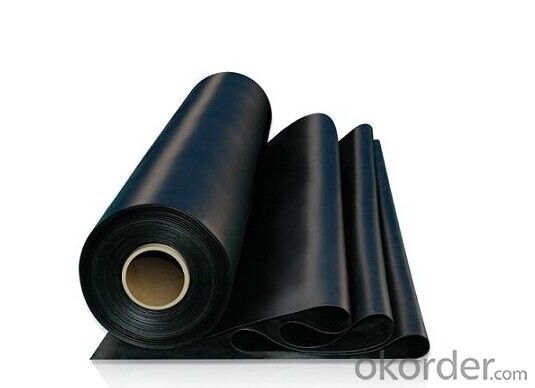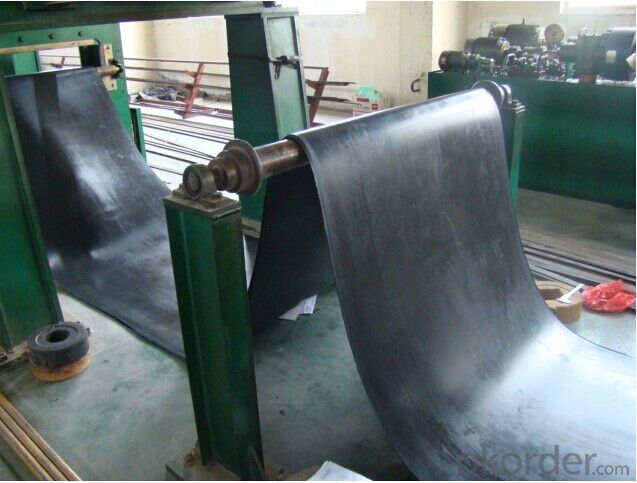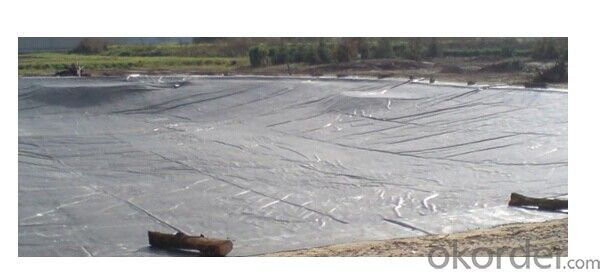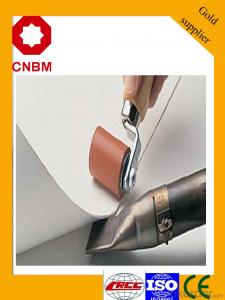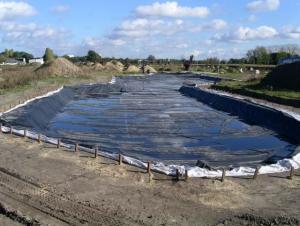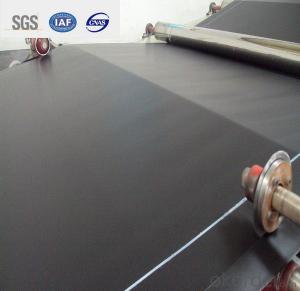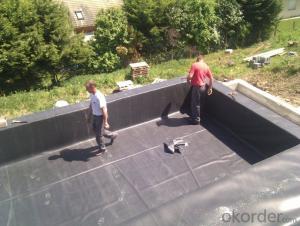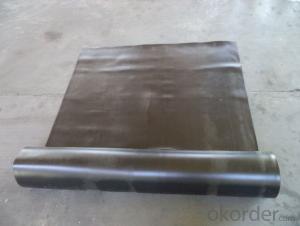EPDM Rubber Waterproof Membrane Pond Liner Use
- Loading Port:
- Qingdao
- Payment Terms:
- TT OR LC
- Min Order Qty:
- 2000 m²
- Supply Capability:
- 300000 m²/month
OKorder Service Pledge
OKorder Financial Service
You Might Also Like
EPDM Waterproof Membrane
Product characteristics for EPDM Waterproof Membrane
1>Excellent anti-aging performance, service life up to 50 years
2>Working well with in -40°C to 100°C,it can be constructed with a single layer in ambient temperature.
3>Waterproofing on various kinds of underground project,industrial of civil buildings and structures. 4>high extension rate, high tensile strength, small size changes at heat treatment
5>Good plant roots penetrability resistance and can be made waterproofing layer of planting roof
6>Special modified molecular structure ,effectively resolving the current domestic and foreign glue joint problem .
7>Good low temperature flexibility, and good performance of adapting to ambient temperature changes. 8>Convenient application ,solid joint, no environment pollution
9>chemical corrosion Resistance, can be used for special occasions
Uses for EPDM Waterproof Membrane
Widely used in roofs, basement, toilet ,swimming pool, and all kinds of industry and civil building waterproofing, reservoir, vivicism, bridge, underground, tunnel and dam waterproofing ,especially to the keystone waterproofing projects which is durability, high corrosion resistance and easy deformation
Specification for EPDM Waterproof Membrane
Item | Thick(mm) | Width | Length(m) | Color |
Spe | 1.0—2.0 | 1.2m/2m/3m/4m | 20 | Black |
Deviation | -1 +15 | --1 | Multicolor |
Technical Data for EPDM Waterproof Membrane
Item | value | ||
JL1 | JF1 | ||
Tensile Strength (Mpa) | normal tamperature | 7.5 | 4.0 |
60°C ≥ | 2.3 | 0.8 | |
Elongation at break (%) | normal tamperature ≥ | 450 | 450 |
-20°C ≥ | 200 | 200 | |
Tear Resistance (N) | ≥ | 25 | 18 |
Water impermeability | 30mm | 0.3Mpa | 0.3Mpa |
Cold bending | (°C) ≤ | -40 | -30 |
Heating Shrinking rate | extand << span=""> | 2 | 2 |
shrink << span=""> | 4 | 4 | |
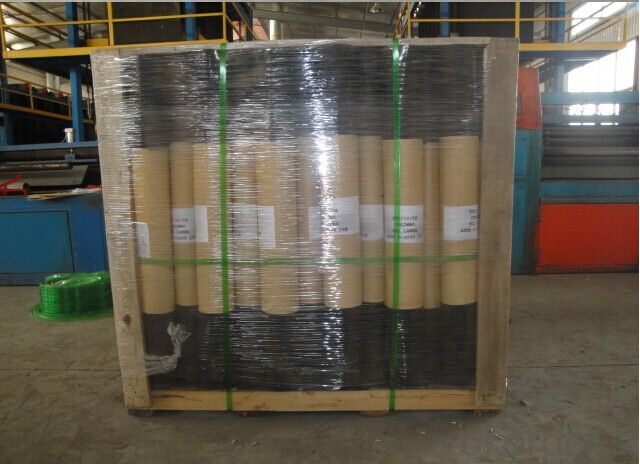
FAQ:
Can you produce 4m width?
Yes, no problem for us. We have four bases in China, largest one in this field.
How many quantity in one 20'' container for 1.2mm and 1.5mm?
480rolls, 11520m2 for 1.2mm and 400rolls, 9600m2 for 1.5mm
Can you provide free samples?
Yes, our samples are free, but express fees usually on buyer's account.
- Q: Can a waterproofing membrane be used for bathrooms or showers?
- Yes, a waterproofing membrane can be used for bathrooms or showers. It is designed to create a protective barrier against water damage, ensuring that the walls, floors, and other surfaces remain dry and free from moisture penetration. This helps to prevent mold, mildew, and structural issues caused by water leakage, making it an essential component in bathroom and shower construction or renovation.
- Q: Can a waterproofing membrane be used in swimming pools or other water features?
- Yes, a waterproofing membrane can be used in swimming pools or other water features to prevent water leakage and maintain a watertight environment.
- Q: Are waterproofing membranes resistant to gas and vapor transmission?
- Waterproofing membranes are generally resistant to the transmission of gas and vapor, which is important in preventing moisture and potentially harmful substances from entering the structure. These membranes act as a barrier against water and are typically made from materials like synthetic rubber, thermoplastic, or bitumen, which have low permeability to gases and vapors. To further enhance their resistance, additives or additional layers are often incorporated. By utilizing waterproofing membranes, one can effectively create a durable barrier against water, gases, and vapors in different construction applications.
- Q: How long does a waterproofing membrane typically last?
- The lifespan of a waterproofing membrane can differ based on various factors like the type and quality of the membrane, how it is installed, environmental conditions, and how well it is maintained. However, on average, a properly installed and well-maintained waterproofing membrane can endure for approximately 10 to 20 years. Some high-quality membranes may even last longer, up to 30 years or more. It is essential to note that regular maintenance, including inspections and necessary repairs, can significantly prolong the lifespan of a waterproofing membrane. Furthermore, factors such as exposure to harsh weather conditions, ultraviolet (UV) radiation, chemicals, and foot traffic can impact the durability of the membrane and may necessitate more frequent maintenance or replacement. To ensure the long-lasting performance of a waterproofing membrane, it is advisable to adhere to the manufacturer's guidelines for installation, maintenance, and repair. It is crucial to conduct regular inspections, particularly after severe weather events or significant changes in the surrounding structures, to promptly identify and address any potential issues. By properly caring for the waterproofing membrane, you can maximize its lifespan and safeguard the underlying structure against water damage.
- Q: Can a waterproofing membrane be used on PVC roofs?
- Yes, a waterproofing membrane can be used on PVC roofs. PVC roofs are commonly used in commercial and residential buildings, and applying a waterproofing membrane can provide an additional layer of protection against water damage and leaks. The membrane is typically made of materials such as synthetic rubber or thermoplastic that are specifically designed to prevent water penetration. By installing a waterproofing membrane on a PVC roof, it can enhance its durability and extend its lifespan.
- Q: Are waterproofing membranes resistant to acid exposure?
- Yes, waterproofing membranes are generally resistant to acid exposure. They are designed to provide a barrier against water and other corrosive substances, including acids. However, the level of resistance may vary depending on the specific type and quality of the membrane used.
- Q: Can a waterproofing membrane be used on precast brick surfaces?
- Yes, a waterproofing membrane can be used on precast brick surfaces. Precast brick surfaces are susceptible to water penetration, which can cause damage to the structure and lead to mold or mildew growth. Applying a waterproofing membrane can provide an effective barrier against water infiltration and protect the precast brick surface. The membrane is typically made of a flexible and durable material such as rubberized asphalt, modified bitumen, or polyurethane. It is applied to the surface using a brush or roller, and it creates a continuous and seamless layer that prevents water from seeping into the bricks. Additionally, the waterproofing membrane can also help to improve the overall thermal insulation of the precast brick surfaces and enhance their longevity. However, it is important to ensure that the precast bricks are clean, dry, and properly prepared before applying the membrane to ensure optimal adhesion and effectiveness.
- Q: Are there any specific considerations for installing a waterproofing membrane on precast concrete surfaces?
- Yes, there are specific considerations for installing a waterproofing membrane on precast concrete surfaces. Here are a few key points to keep in mind: 1. Surface Preparation: Before applying the waterproofing membrane, it is crucial to prepare the precast concrete surface properly. This may involve cleaning the surface, removing any loose particles, and ensuring that it is dry and free from any contaminants. 2. Compatibility: It is important to choose a waterproofing membrane that is compatible with precast concrete surfaces. Some membranes may not adhere well or may not provide effective waterproofing on this type of substrate. Therefore, it is essential to select a membrane specifically designed for use on precast concrete. 3. Adhesion: Ensuring proper adhesion of the waterproofing membrane to the precast concrete surface is vital. The manufacturer's instructions should be followed carefully, including any surface priming or preparation requirements for optimal adhesion. Proper adhesion will help prevent any water infiltration or damage to the concrete. 4. Joint Treatment: Precast concrete surfaces often have joints between panels or other components. These joints need to be properly treated to maintain the waterproofing integrity of the system. This may involve using joint sealants or tapes specifically designed for waterproofing purposes. 5. Durability: Consider the durability and longevity of the waterproofing membrane. Precast concrete surfaces are often exposed to various weather conditions and environmental factors. Therefore, it is crucial to select a membrane that can withstand these conditions and provide long-term protection against water penetration. 6. Quality Assurance: It is recommended to work with experienced professionals or certified installers to ensure the proper installation of the waterproofing membrane on precast concrete surfaces. This will help to minimize any potential installation errors and ensure that the waterproofing system performs as intended. By considering these specific considerations, the installation of a waterproofing membrane on precast concrete surfaces can help protect the concrete from water damage and extend its lifespan.
- Q: Does a waterproofing membrane require any special considerations for installation in earthquake-prone areas?
- Installation of a waterproofing membrane in earthquake-prone areas necessitates special considerations. The ground in these regions is more susceptible to movement and shaking, which can greatly impact the integrity of the waterproofing system. Therefore, it is crucial to take additional precautions to ensure that the membrane is installed properly and capable of withstanding seismic activity. One important factor to consider is the choice of the waterproofing membrane itself. It is advisable to select a membrane that has been specifically designed and tested to endure seismic activity. These membranes are typically more flexible and possess higher tensile strength to accommodate ground movement during earthquakes. Moreover, the installation process should be executed with utmost care and attention to detail. The membrane should be securely anchored or fastened to the substrate using appropriate fasteners and adhesives. Reinforcement techniques, such as using reinforcing fabric or mesh, can also be employed to enhance the membrane's resistance to movement. Additionally, it is essential to ensure that all seams and joints in the membrane are adequately sealed and reinforced. Special attention should be given to areas that are more prone to movement, such as corners, edges, and penetrations. Utilizing compatible and high-quality sealants or adhesives will assist in maintaining the integrity of these vulnerable points. Regular inspections and maintenance are also critical in earthquake-prone areas. Periodically inspecting the membrane for any signs of damage, such as cracks or separations, allows for early detection and timely repairs. Additionally, it is vital to have a contingency plan in place to address any potential damage that may occur during an earthquake, including emergency repair procedures. In conclusion, the installation of a waterproofing membrane in earthquake-prone areas requires careful consideration and adherence to specific guidelines. By selecting an appropriate membrane, properly anchoring and reinforcing it, ensuring proper sealing of seams and joints, and conducting regular inspections, the waterproofing system can be better prepared to withstand earthquakes and provide long-lasting protection against water intrusion.
- Q: Can a waterproofing membrane be used for a sports facility?
- Yes, a waterproofing membrane can be used for a sports facility. A waterproofing membrane is designed to protect structures from water damage by creating a barrier that prevents water from penetrating the surface. In a sports facility, where there may be water-related activities such as swimming pools, showers, or even outdoor sports fields, a waterproofing membrane can be a valuable solution to keep the facility dry and prevent water damage to the structure. Additionally, a waterproofing membrane can also be used to protect the foundation of the sports facility from water infiltration, which can lead to structural issues over time. Therefore, using a waterproofing membrane in a sports facility can ensure the longevity and durability of the facility, as well as provide a safe and dry environment for athletes and visitors.
Send your message to us
EPDM Rubber Waterproof Membrane Pond Liner Use
- Loading Port:
- Qingdao
- Payment Terms:
- TT OR LC
- Min Order Qty:
- 2000 m²
- Supply Capability:
- 300000 m²/month
OKorder Service Pledge
OKorder Financial Service
Similar products
Hot products
Hot Searches
Related keywords

